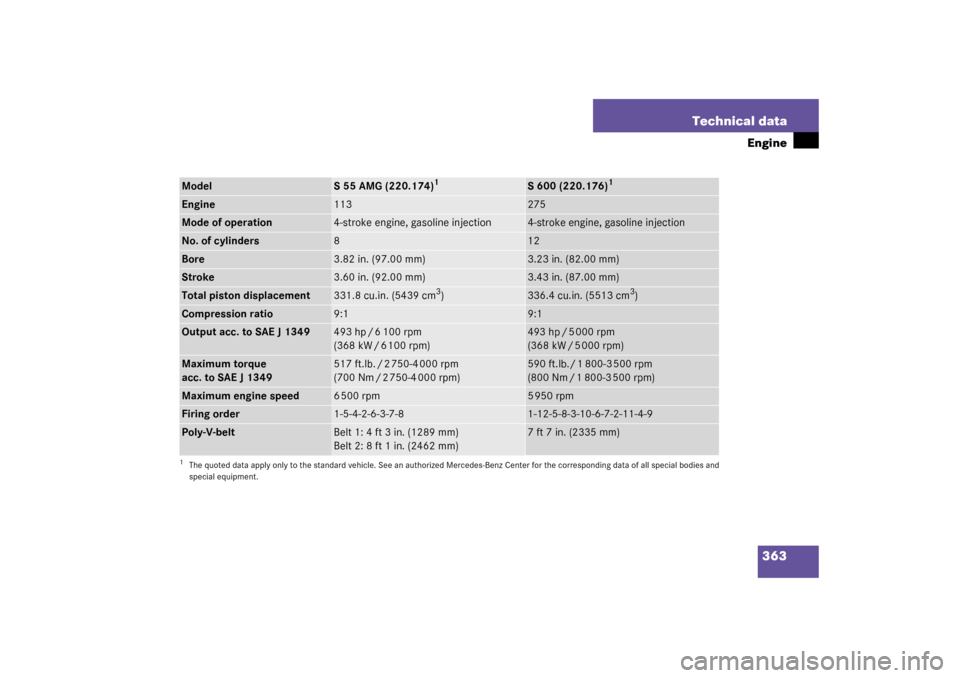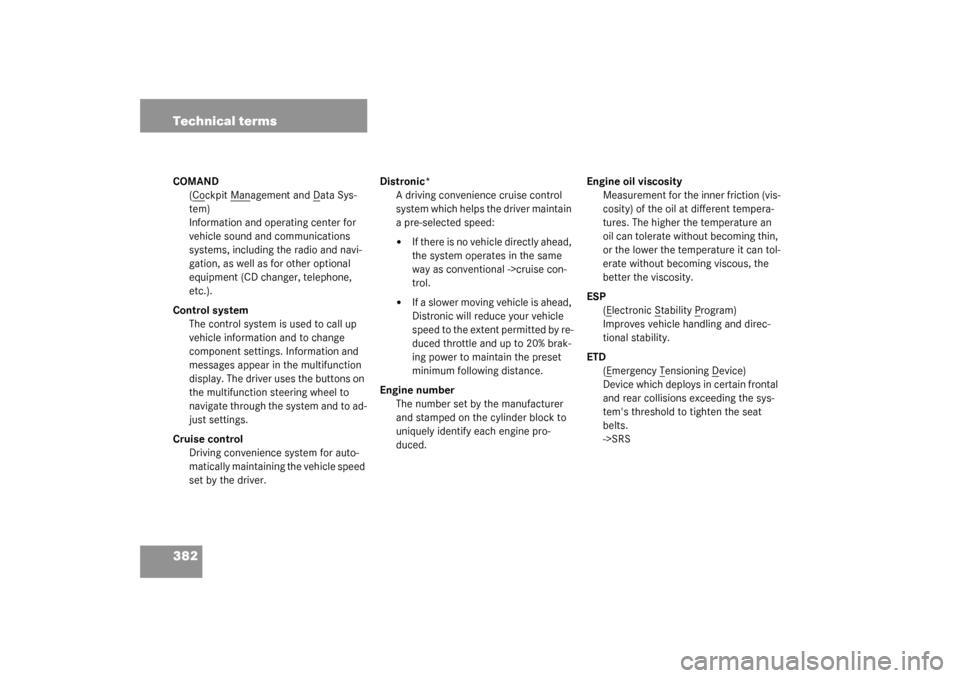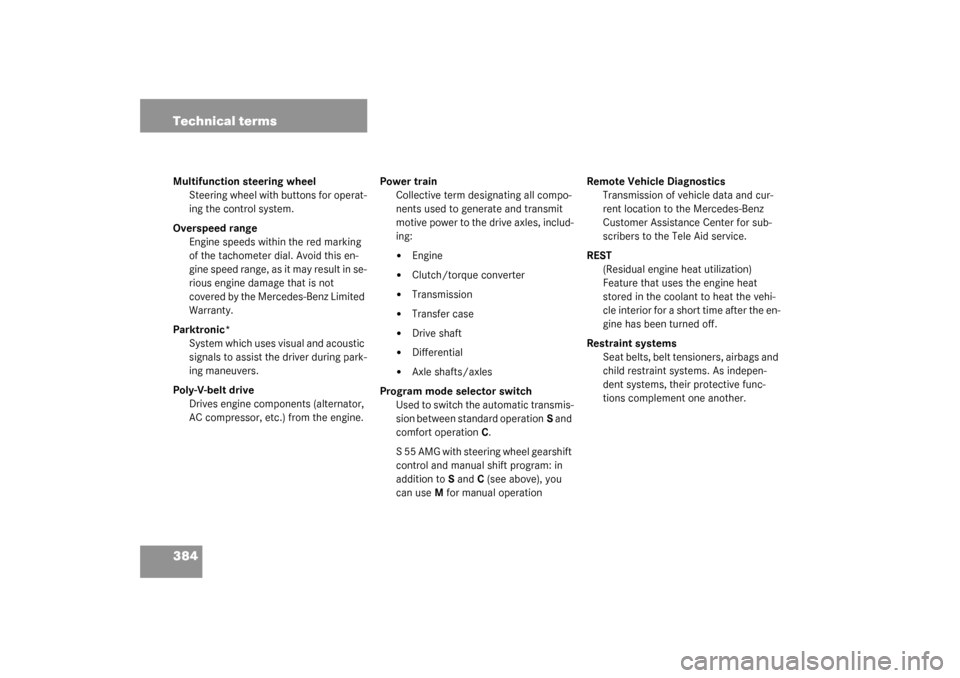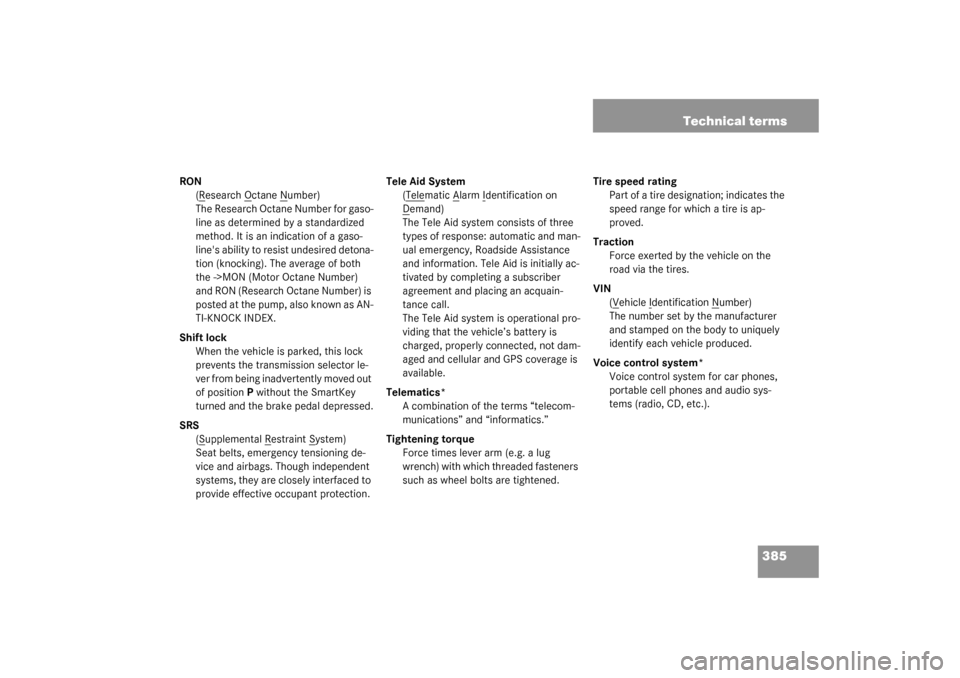Page 316 of 416
316 Practical hintsWhat to do if …?<
SEAT BELT SYSTEM
VISIT WORKSHOP!
The seat belt system is malfunctioning.
�
Visit an authorized Mercedes-Benz
Center as soon as possible.
H
TIRE PRES. MONITOR
PRES. DISPLAY AFTER
DRIVING A FEW MINS. RE-
ACTIVATE USING R BUTTON
The tire pressure is being checked.
TIRE PRES. MONITOR
REACTIVATE!
The tire inflation pressure monitor* is de-
activated.
�
Activate the tire inflation pressure moni-
tor* (
�page 276).
Display
Possible cause
Suggested solution
Warning!
G
Do not drive with a flat tire. A flat tire affects
the ability to steer or brake the vehicle.
You may lose control of the vehicle. Contin-
ued driving with a flat tire will cause exces-
sive heat build-up and possibly a fire.
Page 357 of 416
357 Technical data
Spare parts service
Warranty coverage
Identification labels
Layout of poly-V-belt drive
Engine
Rims and tires
Electrical system
Main dimensions
Weights
Fuels, coolants, lubricants etc.
Consumer information
Page 361 of 416
361 Technical data
Layout of poly-V-belt drive
Layout of poly-V-belt drive
S 430 / S 500
1Automatic belt tensioner
2Power steering pump
3Air conditioning compressor
4Crankshaft
5Coolant pump
6Generator (alternator)
7Idler pulley
S55AMGThe S 55 AMG has two poly-V-belts (belt one
shown in purple/belt two shown in black). 1Idler pulley
2Automatic belt tensioner
3Power steering pump
4Air conditioning compressor
5Crankshaft
6Coolant pump
7Generator (alternator)
8Idler pulley
9Automatic belt tensioner
10Super charger
S600
1Automatic belt tensioner
2Power steering pump
3Air conditioning compressor
4Crankshaft
5Coolant pump
6Generator (alternator)
7Idler pulley
8Idler pulley
9Idler pulley
Page 362 of 416
362 Technical dataEngine
EngineModel
S 430 (220.070, 220.170)
1
1The quoted data apply only to the standard vehicle. See an authorized Mercedes-Benz Center for the corresponding data of all special bodies and
special equipment.
S 500 (220.175)
1
S 430 4MATIC (220.183)
1
S 500 4MATIC (220.184)
1
Engine
113
113
Mode of operation
4-stroke engine, gasoline injection
4-stroke engine, gasoline injection
No. of cylinders
8
8
Bore
3.54 in. (89.90 mm)
3.82 in. (97.00 mm)
Stroke
3.31 in. (84.00 mm)
3.31 in. (84.00 mm)
Total piston displacement
260.3 cu.in. (4266 cm
3)
303.0 cu.in. (4966 cm
3)
Compression ratio
10:1
10:1
Output acc. to SAE J 1349
275 hp / 5750 rpm
(205 kW / 5750 rpm)
302 hp / 5500 rpm
(225 kW / 5500 rpm)
Maximum torque
acc. to SAE J 1349
295 ft.lb. / 2700 rpm
(400 Nm / 3000 rpm)
339 ft.lb. / 2700 rpm
(460 Nm / 2700 rpm)
Maximum engine speed
6000 rpm
6000 rpm
Firing order
1-5-4-2-6-3-7-8
1-5-4-2-6-3-7-8
Poly-V-belt
7 ft 10 in. (2390 mm)
7 ft 10 in. (2390 mm)
Page 363 of 416

363 Technical data
Engine
Model
S 55 AMG (220.174)
1
S 600 (220.176)
1
Engine
113
275
Mode of operation
4-stroke engine, gasoline injection
4-stroke engine, gasoline injection
No. of cylinders
8
12
Bore
3.82 in. (97.00 mm)
3.23 in. (82.00 mm)
Stroke
3.60 in. (92.00 mm)
3.43 in. (87.00 mm)
Total piston displacement
331.8cu.in. (5439cm
3)
336.4 cu.in. (5513 cm
3)
Compression ratio
9:1
9:1
Output acc. to SAE J 1349
493 hp / 6 100 rpm
(368 kW / 6 100 rpm)
493 hp / 5 000 rpm
(368 kW / 5 000 rpm)
Maximum torque
acc. to SAE J 1349
517 ft.lb. / 2 750-4 000 rpm
(700 Nm / 2 750-4 000 rpm)
590 ft.lb./ 1 800-3 500 rpm
(800 Nm / 1 800-3 500 rpm)
Maximum engine speed
6500 rpm
5 950 rpm
Firing order
1-5-4-2-6-3-7-8
1-12-5-8-3-10-6-7-2-11-4-9
Poly-V-belt
Belt 1: 4 ft 3 in. (1289 mm)
Belt 2: 8 ft 1 in. (2462 mm)
7 ft 7 in. (2335 mm)
1The quoted data apply only to the standard vehicle. See an authorized Mercedes-Benz Center for the corresponding data of all special bodies and
special equipment.
Page 382 of 416

382 Technical termsCOMAND
(C
ockpit M
anagement and D
ata Sys-
tem)
Information and operating center for
vehicle sound and communications
systems, including the radio and navi-
gation, as well as for other optional
equipment (CD changer, telephone,
etc.).
Control system
The control system is used to call up
vehicle information and to change
component settings. Information and
messages appear in the multifunction
display. The driver uses the buttons on
the multifunction steering wheel to
navigate through the system and to ad-
just settings.
Cruise control
Driving convenience system for auto-
matically maintaining the vehicle speed
set by the driver.Distronic*
A driving convenience cruise control
system which helps the driver maintain
a pre-selected speed:
�
If there is no vehicle directly ahead,
the system operates in the same
way as conventional ->cruise con-
trol.
�
If a slower moving vehicle is ahead,
Distronic will reduce your vehicle
speed to the extent permitted by re-
duced throttle and up to 20% brak-
ing power to maintain the preset
minimum following distance.
Engine number
The number set by the manufacturer
and stamped on the cylinder block to
uniquely identify each engine pro-
duced.Engine oil viscosity
Measurement for the inner friction (vis-
cosity) of the oil at different tempera-
tures. The higher the temperature an
oil can tolerate without becoming thin,
or the lower the temperature it can tol-
erate without becoming viscous, the
better the viscosity.
ESP
(E
lectronic S
tability P
rogram)
Improves vehicle handling and direc-
tional stability.
ETD
(E
mergency T
ensioning D
evice)
Device which deploys in certain frontal
and rear collisions exceeding the sys-
tem's threshold to tighten the seat
belts.
->SRS
Page 384 of 416

384 Technical termsMultifunction steering wheel
Steering wheel with buttons for operat-
ing the control system.
Overspeed range
Engine speeds within the red marking
of the tachometer dial. Avoid this en-
gine speed range, as it may result in se-
rious engine damage that is not
covered by the Mercedes-Benz Limited
Warranty.
Parktronic*
System which uses visual and acoustic
signals to assist the driver during park-
ing maneuvers.
Poly-V-belt drive
Drives engine components (alternator,
AC compressor, etc.) from the engine.Power train
Collective term designating all compo-
nents used to generate and transmit
motive power to the drive axles, includ-
ing:
�
Engine
�
Clutch/torque converter
�
Transmission
�
Transfer case
�
Drive shaft
�
Differential
�
Axle shafts/axles
Program mode selector switch
Used to switch the automatic transmis-
sion between standard operationS and
comfort operationC.
S 55 AMG with steering wheel gearshift
control and manual shift program: in
addition toS andC (see above), you
can useM for manual operationRemote Vehicle Diagnostics
Transmission of vehicle data and cur-
rent location to the Mercedes-Benz
Customer Assistance Center for sub-
scribers to the Tele Aid service.
REST
(Residual engine heat utilization)
Feature that uses the engine heat
stored in the coolant to heat the vehi-
cle interior for a short time after the en-
gine has been turned off.
Restraint systems
Seat belts, belt tensioners, airbags and
child restraint systems. As indepen-
dent systems, their protective func-
tions complement one another.
Page 385 of 416

385 Technical terms
RON
(R
esearch O
ctane N
umber)
The Research Octane Number for gaso-
line as determined by a standardized
method. It is an indication of a gaso-
line's ability to resist undesired detona-
tion (knocking). The average of both
the ->MON (Motor Octane Number)
and RON (Research Octane Number) is
posted at the pump, also known as AN-
TI-KNOCK INDEX.
Shift lock
When the vehicle is parked, this lock
prevents the transmission selector le-
ver from being inadvertently moved out
of positionP without the SmartKey
turned and the brake pedal depressed.
SRS
(S
upplemental R
estraint S
ystem)
Seat belts, emergency tensioning de-
vice and airbags. Though independent
systems, they are closely interfaced to
provide effective occupant protection.Tele Aid System
(T
elematic A
larm I
dentification on
D
emand)
The Tele Aid system consists of three
types of response: automatic and man-
ual emergency, Roadside Assistance
and information. Tele Aid is initially ac-
tivated by completing a subscriber
agreement and placing an acquain-
tance call.
The Tele Aid system is operational pro-
viding that the vehicle’s battery is
charged, properly connected, not dam-
aged and cellular and GPS coverage is
available.
Telematics*
A combination of the terms “telecom-
munications” and “informatics.”
Tightening torque
Force times lever arm (e.g. a lug
wrench) with which threaded fasteners
such as wheel bolts are tightened.Tire speed rating
Part of a tire designation; indicates the
speed range for which a tire is ap-
proved.
Traction
Force exerted by the vehicle on the
road via the tires.
VIN
(V
ehicle I
dentification N
umber)
The number set by the manufacturer
and stamped on the body to uniquely
identify each vehicle produced.
Voice control system*
Voice control system for car phones,
portable cell phones and audio sys-
tems (radio, CD, etc.).